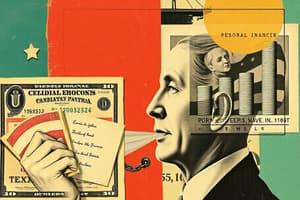Podcast
Questions and Answers
When the stock markets crashed the most heavily affected investments were those that were _____.
When the stock markets crashed the most heavily affected investments were those that were _____.
poorly diversified
The best way to earn money long term is _____.
The best way to earn money long term is _____.
stocks, bonds, and mutual funds
Savings is the _____.
Savings is the _____.
accumulation of excess funds by intentionally spending less than you earn
Investing is the ____.
Investing is the ____.
The most common way that people invest is by putting money into assets called _____.
The most common way that people invest is by putting money into assets called _____.
Stocks are _____.
Stocks are _____.
Bonds ____.
Bonds ____.
All of your investments make up your _____.
All of your investments make up your _____.
When people invest money they take a ____.
When people invest money they take a ____.
Investors hope that their investments will earn them a ____.
Investors hope that their investments will earn them a ____.
Current income is ____.
Current income is ____.
Interest ____.
Interest ____.
Rent is ____.
Rent is ____.
Dividend is ____.
Dividend is ____.
A capital gain occurs when ____.
A capital gain occurs when ____.
Capital losses are when ____.
Capital losses are when ____.
The rate of return is ____.
The rate of return is ____.
Pure risk ____.
Pure risk ____.
Speculative risk ____.
Speculative risk ____.
Investment risk ____.
Investment risk ____.
T-bill ____.
T-bill ____.
When making investments, people demand a ____.
When making investments, people demand a ____.
Risk tolerance is the ____.
Risk tolerance is the ____.
Investment philosophy is the ____.
Investment philosophy is the ____.
A conservative investment philosophy generally means ____.
A conservative investment philosophy generally means ____.
Preservation of capital means ____.
Preservation of capital means ____.
People with a moderate investment philosophy are usually ____.
People with a moderate investment philosophy are usually ____.
People with an aggressive investment philosophy are usually characterized as ____.
People with an aggressive investment philosophy are usually characterized as ____.
Active investing involves ____.
Active investing involves ____.
You can invest money in two ways: ____.
You can invest money in two ways: ____.
The lending investments (debts) offer ____.
The lending investments (debts) offer ____.
Fixed maturity means ____.
Fixed maturity means ____.
Fixed income ____.
Fixed income ____.
Equities ____.
Equities ____.
Random risk ____.
Random risk ____.
To counteract random risk you ____.
To counteract random risk you ____.
Market risk ____.
Market risk ____.
Financial risk ____.
Financial risk ____.
Inflation risk ____.
Inflation risk ____.
Time horizon risk ____.
Time horizon risk ____.
Business cycle risk ____.
Business cycle risk ____.
Market-volatility risk ____.
Market-volatility risk ____.
Liquidity risk ____.
Liquidity risk ____.
Commissions ____.
Commissions ____.
Leverage ____.
Leverage ____.
Securities markets ____.
Securities markets ____.
A bull market ____.
A bull market ____.
A bear market ____.
A bear market ____.
A market correction ____.
A market correction ____.
Market volatility ____.
Market volatility ____.
Market timers ____.
Market timers ____.
Market efficiency ____.
Market efficiency ____.
Herd behavior ____.
Herd behavior ____.
Buy and hold ____.
Buy and hold ____.
Dollar-cost averaging ____.
Dollar-cost averaging ____.
Below-average costs ____.
Below-average costs ____.
Average share price ____.
Average share price ____.
Average share cost ____.
Average share cost ____.
Asset allocation ____.
Asset allocation ____.
A limited managed account ____.
A limited managed account ____.
Monte Carlo analysis ____.
Monte Carlo analysis ____.
An investment plan ____.
An investment plan ____.
The business cycle ____.
The business cycle ____.
A corporate bond ____.
A corporate bond ____.
A dividend ____.
A dividend ____.
Economics ____.
Economics ____.
An emergency fund ____.
An emergency fund ____.
Equity capital ____.
Equity capital ____.
A government bond ____.
A government bond ____.
A line of credit ____.
A line of credit ____.
Liquidity ____.
Liquidity ____.
A maturity date ____.
A maturity date ____.
A mutual fund ____.
A mutual fund ____.
The rate of return ____.
The rate of return ____.
A speculative investment ____.
A speculative investment ____.
What are the typical asset classes? (Select all that apply)
What are the typical asset classes? (Select all that apply)
A 401(k) ____.
A 401(k) ____.
An annual fee ____.
An annual fee ____.
An annual percentage rate (APR) ____.
An annual percentage rate (APR) ____.
An asset ____.
An asset ____.
Bankruptcy ____.
Bankruptcy ____.
A bond ____.
A bond ____.
A budget ____.
A budget ____.
Capital ____.
Capital ____.
Capital gains ____.
Capital gains ____.
A certificate of deposit (CD) ____.
A certificate of deposit (CD) ____.
Collateral ____.
Collateral ____.
Compound interest ____.
Compound interest ____.
Credit ____.
Credit ____.
A credit bureau ____.
A credit bureau ____.
A credit card ____.
A credit card ____.
A credit history ____.
A credit history ____.
A credit report ____.
A credit report ____.
A credit report agency ____.
A credit report agency ____.
A credit score ____.
A credit score ____.
A debit card ____.
A debit card ____.
Debt ____.
Debt ____.
A dividend ____.
A dividend ____.
A down payment ____.
A down payment ____.
Flashcards
Savings
Savings
Savings represent the intentional accumulation of excess funds by spending less than one earns.
Investing
Investing
Using saved money to generate additional income.
Primary investment assets
Primary investment assets
Securities like stocks, bonds, and mutual funds.
Stocks
Stocks
Signup and view all the flashcards
Bonds
Bonds
Signup and view all the flashcards
Portfolio
Portfolio
Signup and view all the flashcards
Financial risk
Financial risk
Signup and view all the flashcards
Total return aim
Total return aim
Signup and view all the flashcards
Current income
Current income
Signup and view all the flashcards
Interest
Interest
Signup and view all the flashcards
Dividends
Dividends
Signup and view all the flashcards
Capital gain
Capital gain
Signup and view all the flashcards
Capital loss
Capital loss
Signup and view all the flashcards
Rate of return
Rate of return
Signup and view all the flashcards
Pure risk
Pure risk
Signup and view all the flashcards
Speculative risk
Speculative risk
Signup and view all the flashcards
Inflation risk
Inflation risk
Signup and view all the flashcards
Risk tolerance
Risk tolerance
Signup and view all the flashcards
Conservative
Conservative
Signup and view all the flashcards
Aggressive
Aggressive
Signup and view all the flashcards
Active investing
Active investing
Signup and view all the flashcards
Market corrections
Market corrections
Signup and view all the flashcards
Market risk
Market risk
Signup and view all the flashcards
Volatility risk
Volatility risk
Signup and view all the flashcards
Liquidity risk
Liquidity risk
Signup and view all the flashcards
Leverage
Leverage
Signup and view all the flashcards
Securities markets
Securities markets
Signup and view all the flashcards
Bull markets
Bull markets
Signup and view all the flashcards
Bear markets
Bear markets
Signup and view all the flashcards
Emergency fund
Emergency fund
Signup and view all the flashcards
Study Notes
Personal Finance Key Concepts
- Poorly diversified investments are most vulnerable during stock market crashes.
- Long-term earnings are best achieved through stocks, bonds, and mutual funds.
- Savings represent the intentional accumulation of excess funds by spending less than one earns.
Investments Overview
- Investing involves using saved money to generate additional income.
- The primary assets for investing include securities like stocks, bonds, and mutual funds.
- Stocks signify ownership in a corporation, while bonds represent loans to companies or governments.
- An individual’s total investments are collectively known as a portfolio.
Risk and Returns
- Financial risk arises when investments fail to generate returns.
- Investors aim for a positive total return, combining current income and capital gains.
- Current income consists of money received regularly from investments (interest, rent, dividends).
- Interest is compensation for lending money, while dividends are corporate earnings paid to shareholders.
- Capital gains occur when an investment is sold at a higher value, whereas capital losses reflect a drop in investment value.
Investment Metrics
- The rate of return is calculated as the total return expressed as a percentage of the original investment amount.
- Pure risk involves potential loss without any chance of gain, while speculative risk includes both potential gains and losses.
- Inflation risk indicates that the investment will not grow as fast as inflation, affecting its future value.
Investment Strategies
- Risk tolerance refers to an investor's ability to endure market fluctuations.
- Investment philosophy can be categorized as conservative, moderate, or aggressive based on risk acceptance.
- Conservative strategies minimize risk for low returns, while aggressive strategies seek high rewards at higher risks.
Market Insights
- Active investing requires monitoring economic trends and frequently adjusting portfolios.
- Common investment strategies include buy-and-hold, dollar-cost averaging, and maintaining below-average costs.
- Market corrections signify a temporary decline in market prices to adjust for artificial inflation in asset values.
Securities and Market Dynamics
- T-bills are risk-free short-term investments with minimal returns (0.25%-0.35%).
- Market risk reflects potential losses from overall financial market performance, while volatility risk refers to sharp price changes due to specific company events.
- Liquidity risk highlights the challenge of quickly selling assets without loss.
Complex Investments
- Leverage involves using borrowed capital for investment to exceed potential returns.
- Securities markets are platforms for buying and selling stocks and bonds, influenced by market conditions.
- Market periods are categorized into bull markets (20%+ gains) and bear markets (20%+ losses).
Financial Management Tools
- An emergency fund provides quick access to cash during urgent financial needs.
- A budget is a strategic plan outlining expenditure against income.
- Asset allocation involves diversifying investments across various asset classes to minimize risk.
- Monte Carlo analysis simulates potential investment outcomes to assess risks and returns.
Credit and Debt Information
- Credit is the agreement for delayed payment after receiving goods or services.
- Credit scores reflect an individual's creditworthiness based on past usage and payment performance.
- Different accounts, such as 401(k) retirement plans or credit cards, come with specific terms related to fees and rates.
Key Terminology
- Capital includes wealth in monetary or property form.
- A mutual fund pools investor money to diversify investments across various securities.
- Bankruptcy signifies an individual or entity’s inability to meet financial obligations.
Asset Classes and Investment Structures
- Equity capital pertains to funds raised from owners, while collateral serves as security for loans.
- Common asset classes include large-cap stocks, small-cap stocks, bonds, and cash, each with unique risk-return profiles.
- Certificates of deposit are time-bound savings products offering fixed interest rates.
Summary
- Knowledge and management of personal finance, investments, risks, and credit are crucial for long-term financial health.
- Understanding how various economic factors and personal choices impact wealth accumulation provides a foundation for informed financial decision-making.
Studying That Suits You
Use AI to generate personalized quizzes and flashcards to suit your learning preferences.




